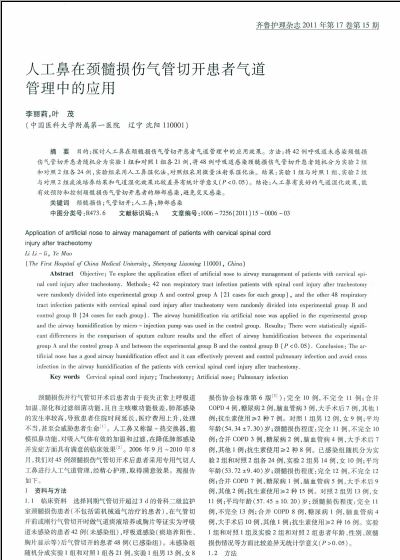人工鼻在颈髓损伤气管切开患者气道管理中的应用(1)
 |
| 第1页 |
参见附件。
摘 要 目的:探讨人工鼻在颈髓损伤气管切开患者气道管理中的应用效果。方法:将42例呼吸道未感染颈髓损伤气管切开患者随机分为实验1组和对照1组各21例,将48例呼吸道感染颈髓损伤气管切开患者随机分为实验2组和对照2组各24例,实验组采用人工鼻湿化法,对照组采用微量注射泵湿化法。结果:实验1组与对照1组、实验2组与对照2组痰液培养结果和气道湿化效果比较差异有统计学意义(P<0.05)。结论:人工鼻有良好的气道湿化效果,能有效预防和控制颈髓损伤气管切开患者的肺部感染,避免交叉感染。
关键词 颈髓损伤;气管切开;人工鼻;肺部感染
中图分类号:R473.6 文献标识码:A 文章编号:1006-7256(2011)15-0006-03
Application of artificial nose to airway management of patients with cervical spinal cord
injury after tracheotomy
Li Li-li, Ye Mao
(The First Hospital of China Medical University, Shenyang Liaoning 110001, China)
Abstract Objective: To explore the application effect of artificial nose to airway management of patients with cervical spinal cord injury after tracheotomy. Methods: 42 non respiratory tract infection patients with spinal cord injury after tracheotomy were randomly divided into experimental group A and control group A (21 cases for each group), and the other 48 respiratory tract infection patients with cervical spinal cord injury after tracheotomy were randomly divided into experimental group B and control group B (24 cases for each group). The airway humidification via artificial nose was applied in the experimental group and the airway humidification by micro-injection pump was used in the control group. Results: There were statistically significant differences in the comparison of sputum culture results and the effect of airway humidification between the experimental group A and the control group A and between the experimental group B and the control group B (P<0.05). Conclusion: The artificial nose has a good airway humidification effect and it can effectively prevent and control pulmonary infection and avoid cross infection in the airway humidification of the patients with cervical spinal cord injury after tracheotomy.
Key words Cervical spinal cord injury; Tracheotomy; Artificial nose; Pulmonary infection
颈髓损伤并行气管切开术后患者由于丧失正常上呼吸道加温、湿化和过滤细菌功能,且自主咳嗽功能极差,肺部感染的发生率较高,导致患者住院时间延长,医疗费用上升,处理不当,甚至会威胁患者生命[1]。人工鼻又称湿-热交换器,能模拟鼻功能,对吸入气体有效的加温和过滤,在降低肺部感染并发症方面具有满意的临床效果[2]。2006年9月~2010年8月,我们对45例颈髓损伤气管切开术后患者采用专用气切人工鼻进行人工气道管理,经精心护理,取得满意效果。现报告如下。
1 资料与方法
1.1 临床资料 选择同期气管切开超过3 d的骨科二级监护室颈髓损伤患者(不包括需机械通气治疗的患者),在气管切开前或刚行气管切开时做气道痰液培养或胸片等证实为呼吸道未感染的患者42例(未感染组),呼吸道感染(痰培养阳性、胸片显示等)后气管切开的患者48例(已感染组)。未感染组随机分成实验1组和对照1组各21例,实验1组男13例,女8例;平均年龄(56.52±8.40)岁;颈髓损伤程度(采用美国脊柱损伤协会标准第6版[3]):完全10例,不完全11例;合并COPD 4例,糖尿病2例,脑血管病3例,大手术后7例,其他1例;抗生素使用≥2种7例。对照1组男12例,女9例;平均年龄(54 ......
您现在查看是摘要介绍页,详见PDF附件(2375kb)。